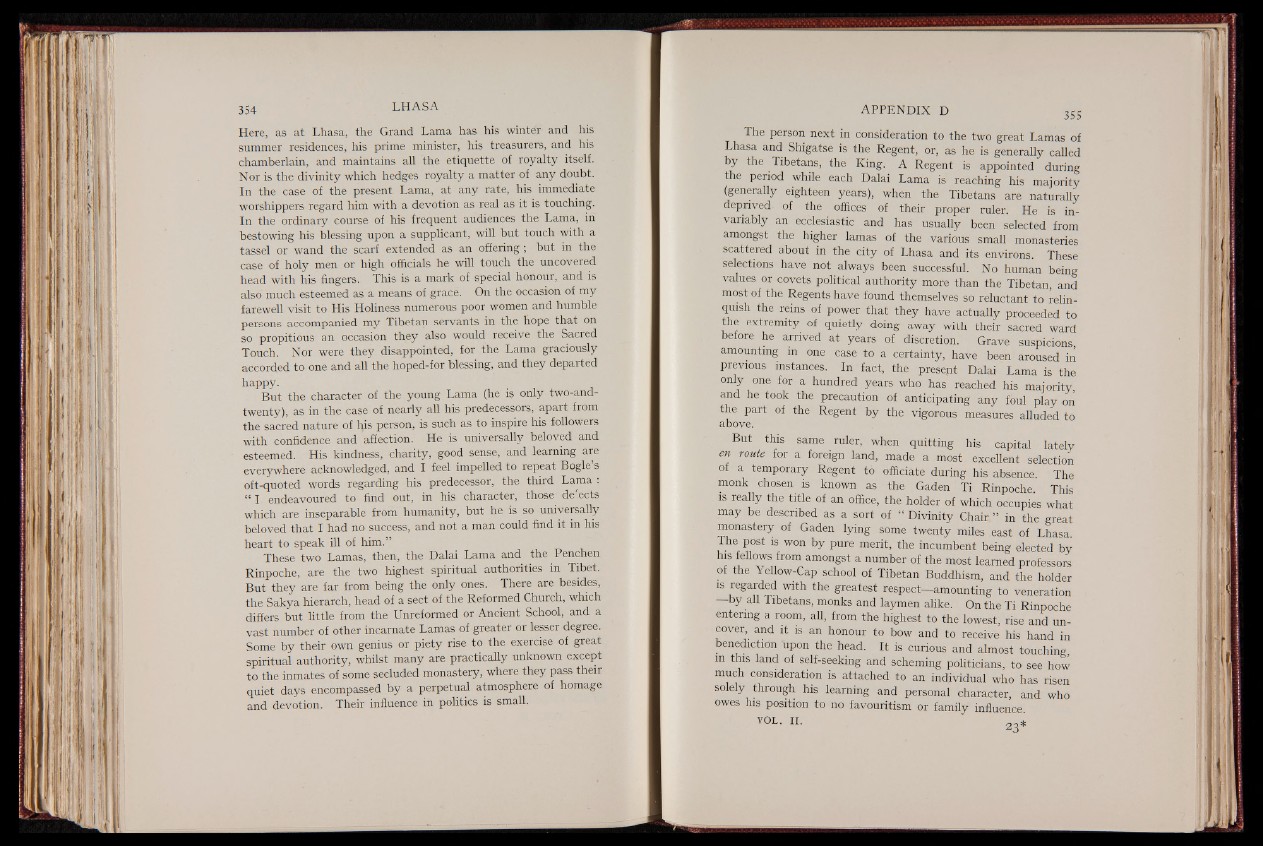
Here, as at Lhasa, the Grand Lama has his winter and his
summer residences, his prime minister, his treasurers, and his
chamberlain, and maintains all the etiquette of royalty itself.
Nor is the divinity which hedges royalty a matter of any doubt.
In the case of the present Lama, at any rate, his immediate
worshippers regard him with a devotion as real as it is touching.
In the ordinary course of his frequent audiences the Lama, in
bestowing his blessing upon a supplicant, will but touch with a
tassel or wand the scarf extended as an offering ; but in the
case of holy men or high officials he will touch the uncovered
head with his fingers. This is a mark of special honour, and is
also much esteemed as a means of grace. On the occasion of my
farewell visit to His Holiness numerous poor women and humble
persons accompanied my Tibetan servants in the hope that on
so propitious an occasion they also would receive the Sacred
Touch. Nor were they disappointed, for the Lama graciously
accorded to one and all the hoped-for blessing, and they departed
happy.
But the character of the young Lama (he is only two-and-
twenty), as in the case of nearly all his predecessors, apart from
the sacred nature of tys person, is such as to inspire his followers
with confidence and affection. He is universally beloved and
esteemed. His kindness, charity, good sense, and learning are
everywhere acknowledged, and I feel impelled to repeat Bogle’s
oft-quoted words regarding his predecessor, the third Lama :
“ I endeavoured to find out, in his character, those de.ects
which are inseparable from humanity, but he is so universally
beloved that I had no success, and not a man could find it in his
heart to speak ill of him.”
These two Lamas, then, the Dalai Lama and the Penchen
Rinpoche, are the two highest spiritual authorities in Tibet.
But they are far from being the only ones. There are besides,
the Sakya hierarch, head of a sect of the Reformed Church, which
differs but little from the Unreformed or Ancient School, and a
vast number of other incarnate Lamas of greater or lesser degree.
Some by their own genius or piety rise to the exercise of great
spiritual authority, whilst many are practically unknown except
to the inmates of some secluded monastery, where they pass their
quiet days encompassed by a perpetual atmosphere of homage
and devotion. Their influence in politics is small.
The person next in consideration to the two great Lamas of
Lhasa and Shigatse is the Regent, or, as he is generally called
y the Tibetans, the King. A Regent is appointed during
the period while each Dalai Lama is reaching his majority
(generally eighteen years), when the Tibetans are naturally
deprived, of the offices of their proper ruler. He is invariably
an ecclesiastic and has usually been selected from
amongst the higher lamas of the various small monasteries
scattered about in the city of Lhasa and its environs. These
selections have not always been successful. N o human b e in g
values or covets political authority more than the Tibetan, and
most of the Regents have found themselves so reluctant to relinquish
the reins of power that they have actually proceeded to
the extremity of quietly doing away with their sacred ward
before he arrived at years of discretion. Grave suspicions,
amounting in one case to a certainty, have been aroused in
previous instances. In fact, the present Dalai Lama is the
only one for a hundred years who has reached his majority,
and he took the precaution of anticipating any foul play on
the part of the Regent by the vigorous measures alluded to
above.
But this same ruler, when quitting his capital lately
en route for a foreign land, made a most excellent selection
of a temporary Regent to officiate during his absence. The
monk chosen is known as the Gaden Ti Rinpoche. This
is really the title of an office, the holder of which occupies what
may be described as a sort of “ Divinity Chair ” in the great
monastery of Gaden lying some twenty miles east of Lhasa.
The post is won by pure merit, the incumbent being elected by
his feUows from amongst a number of the most learned professors
of the Yellow-Cap school of Tibetan Buddhism, and the holder
is regarded with the greatest respect— amounting to veneration
—by all Tibetans, monks and laymen alike. On the Ti Rinpoche
entering a room, all, from the highest to the lowest, rise and uncover,
and it is an honour to bow and to receive his hand in
benediction upon the head. It is curious and almost touching
m this land of self-seeking and scheming politicians, to see how
much consideration is attached to an individual who has risen
solely through his learning and personal character, and who
owes his position to no favouritism or family influence.
V O L . I I . *